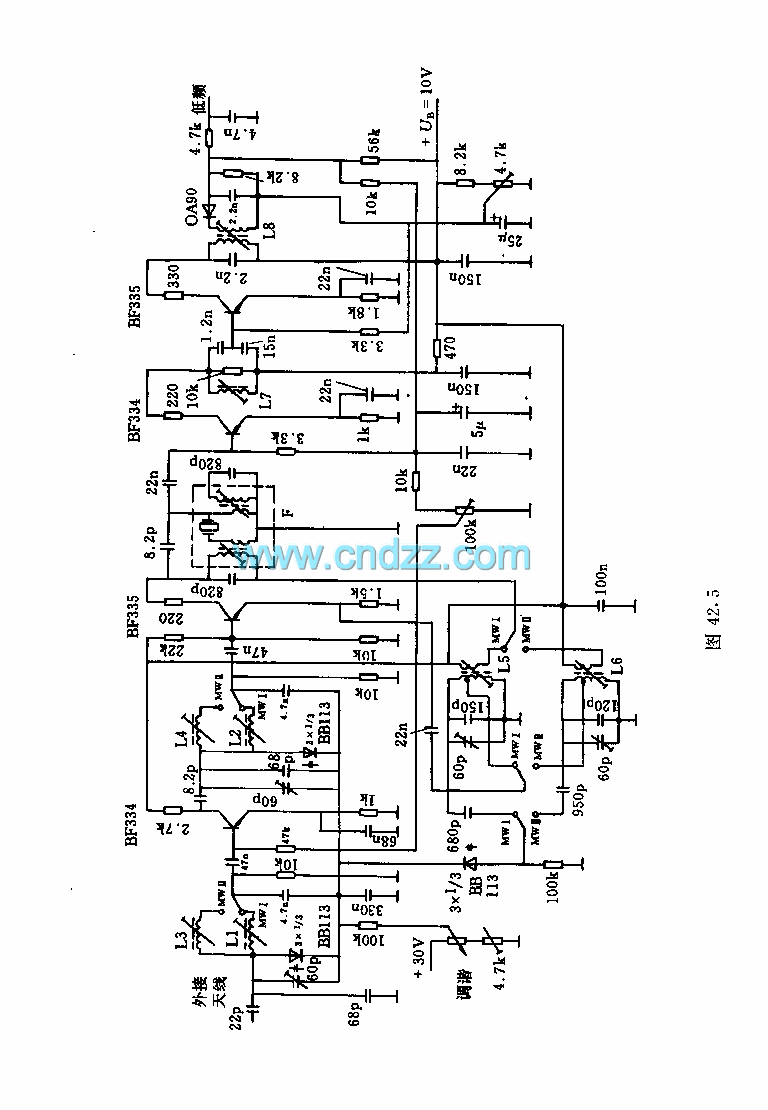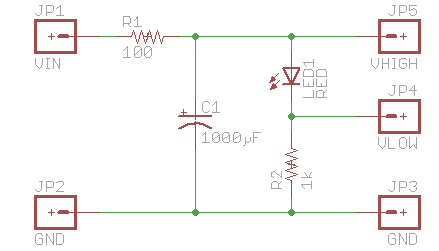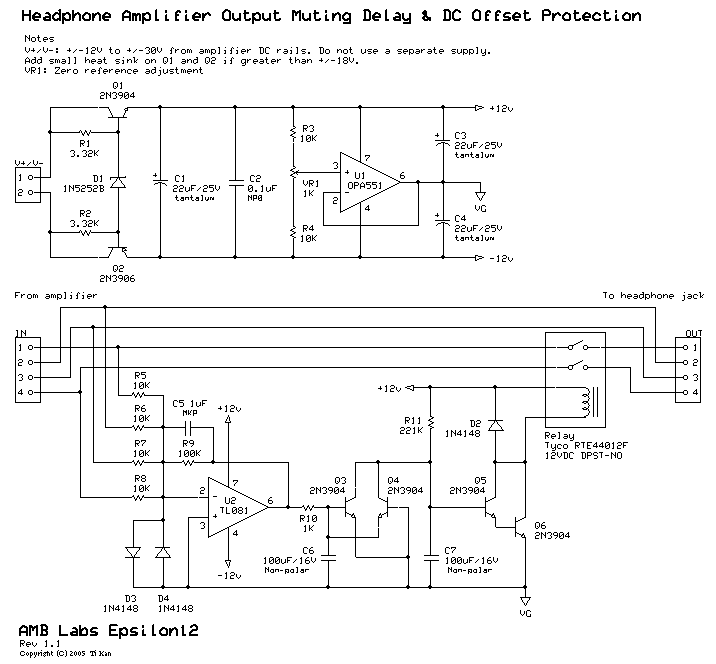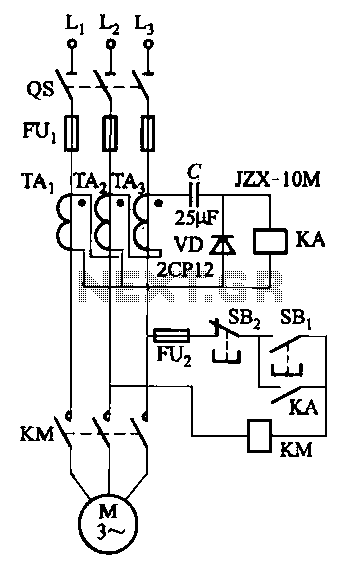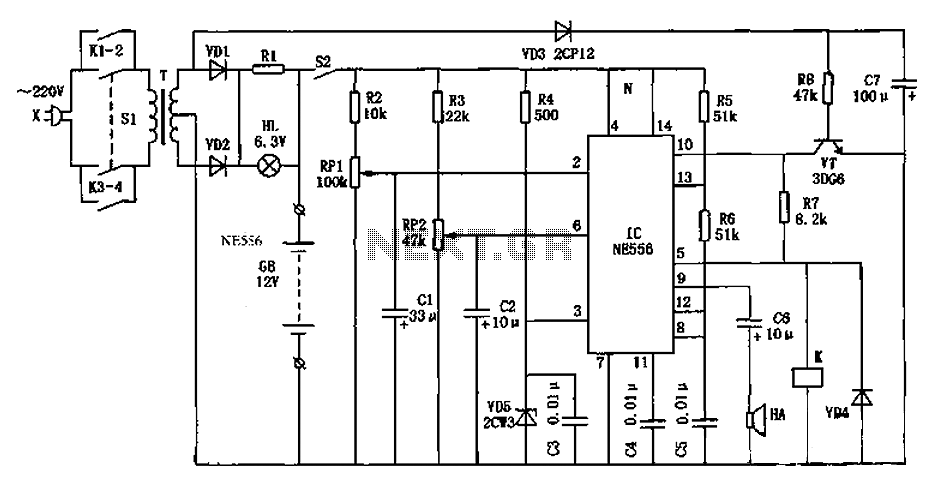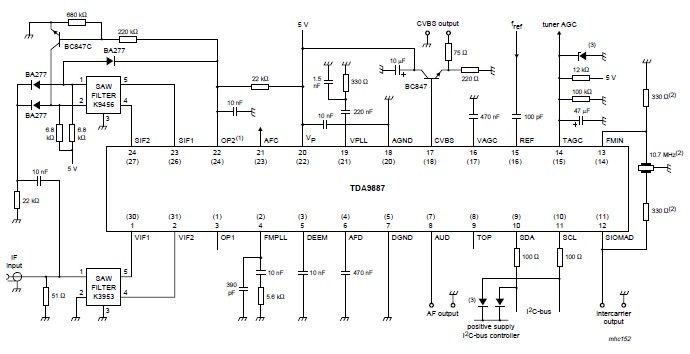
Multiple waveform generator circuit diagram
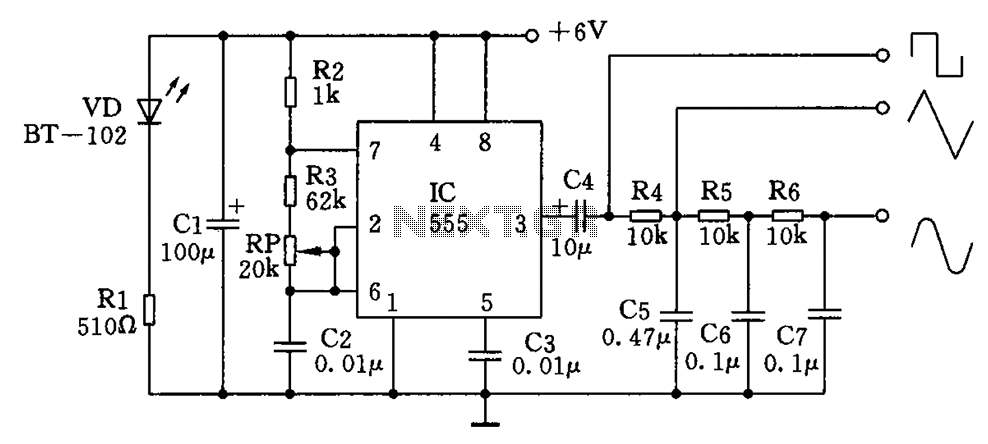
The circuit simultaneously generates a square wave, triangle wave, and sine wave, making it particularly suitable for electronics enthusiasts and students who wish to observe signal waveforms using an oscilloscope. This signal generator circuit is simple, low-cost, and allows for easy adjustments. The 555 timer is configured as a multivibrator, with capacitor C2 serving as the timing capacitor. The charging circuit consists of resistors R2, R3, and potentiometer RP along with capacitor C2, while the discharge circuit includes capacitor C2, potentiometer RP, resistor R3, and pin 7 of the IC (discharge). The charging time constant and discharging time constant are approximately equal, resulting in a symmetrical square wave output at pin 3 of the IC. With the specified component values, the output frequency is around 1 kHz, and adjusting the potentiometer RP modifies the oscillator frequency. The square wave signal is processed through resistor R4 and capacitor C5 to produce a triangular wave output. The triangular wave is further processed through resistor R5 and capacitor C6 to yield an approximate sine wave output. Capacitor C1 functions as a power supply filter, and a light-emitting diode (LED) serves as a power indicator.
The circuit utilizes a 555 timer IC configured in astable mode, which is essential for generating continuous waveforms. The timing capacitor C2, in conjunction with the resistors R2, R3, and the variable resistor RP, establishes the frequency of oscillation. The relationship between the resistors and capacitor determines the charging and discharging cycles, which are critical for achieving the desired waveform characteristics.
Upon powering the circuit, the 555 timer generates a square wave output at pin 3. The frequency of the square wave can be adjusted by varying the resistance of the potentiometer RP, allowing for a range of output frequencies. The square wave is then passed through an integration network formed by resistor R4 and capacitor C5, which smooths the transitions of the square wave, resulting in a triangular waveform. This triangular waveform is further refined through another integration network comprising resistor R5 and capacitor C6, which approximates a sine wave output.
Capacitor C1 plays a crucial role in stabilizing the power supply by filtering out any noise, ensuring that the 555 timer operates effectively. The inclusion of an LED as a power indicator provides a visual cue to the user that the circuit is functioning properly. Overall, this signal generator circuit is an excellent educational tool for understanding waveform generation and the principles of oscillation in electronic circuits. Circuit is shown at the same time produce a square wave, triangle wave, sine wave and outputs, especially for electronics enthusiasts and students do with an oscilloscope to ob serve the signal waveform of the experiment. The signal generator circuit is simple, low cost, easy adjustment. 555 timer connected as multivibrator forms of work, C2 for the timing capacitor, C2 of the charging circuit is R2 R3 RP C2; C2 discharge circuit is C2 RP R3 IC 7 feet (discharge). Since R3 + RP R2, the charging time constant and the discharging time constant approximately equal to the 3-pin output of the IC is approximately symmetrical square wave.
Press the component parameters as shown in Figure, the frequency is about 1kHz, adjust the potentiometer RP can change the frequency of the oscillator. Square wave signal by R4, after the C5 integration network, the output of the triangular wave. Triangle wave and then by R5, C6 integration network, the approximate sine wave output. C1 is the power supply filter capacitor. Used as a power indicator light-emitting diode VD.
The circuit utilizes a 555 timer IC configured in astable mode, which is essential for generating continuous waveforms. The timing capacitor C2, in conjunction with the resistors R2, R3, and the variable resistor RP, establishes the frequency of oscillation. The relationship between the resistors and capacitor determines the charging and discharging cycles, which are critical for achieving the desired waveform characteristics.
Upon powering the circuit, the 555 timer generates a square wave output at pin 3. The frequency of the square wave can be adjusted by varying the resistance of the potentiometer RP, allowing for a range of output frequencies. The square wave is then passed through an integration network formed by resistor R4 and capacitor C5, which smooths the transitions of the square wave, resulting in a triangular waveform. This triangular waveform is further refined through another integration network comprising resistor R5 and capacitor C6, which approximates a sine wave output.
Capacitor C1 plays a crucial role in stabilizing the power supply by filtering out any noise, ensuring that the 555 timer operates effectively. The inclusion of an LED as a power indicator provides a visual cue to the user that the circuit is functioning properly. Overall, this signal generator circuit is an excellent educational tool for understanding waveform generation and the principles of oscillation in electronic circuits. Circuit is shown at the same time produce a square wave, triangle wave, sine wave and outputs, especially for electronics enthusiasts and students do with an oscilloscope to ob serve the signal waveform of the experiment. The signal generator circuit is simple, low cost, easy adjustment. 555 timer connected as multivibrator forms of work, C2 for the timing capacitor, C2 of the charging circuit is R2 R3 RP C2; C2 discharge circuit is C2 RP R3 IC 7 feet (discharge). Since R3 + RP R2, the charging time constant and the discharging time constant approximately equal to the 3-pin output of the IC is approximately symmetrical square wave.
Press the component parameters as shown in Figure, the frequency is about 1kHz, adjust the potentiometer RP can change the frequency of the oscillator. Square wave signal by R4, after the C5 integration network, the output of the triangular wave. Triangle wave and then by R5, C6 integration network, the approximate sine wave output. C1 is the power supply filter capacitor. Used as a power indicator light-emitting diode VD.
